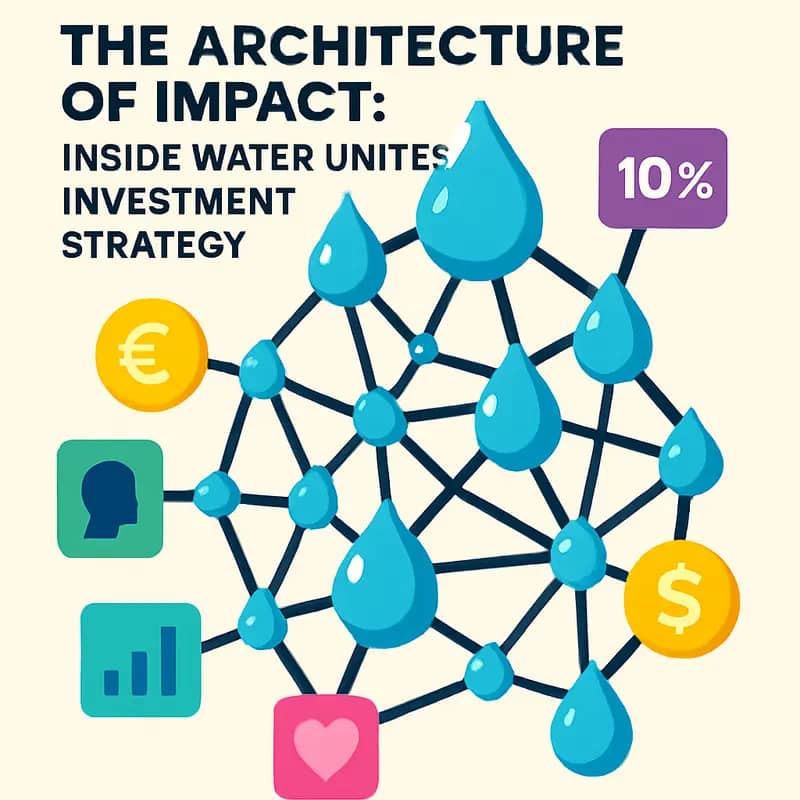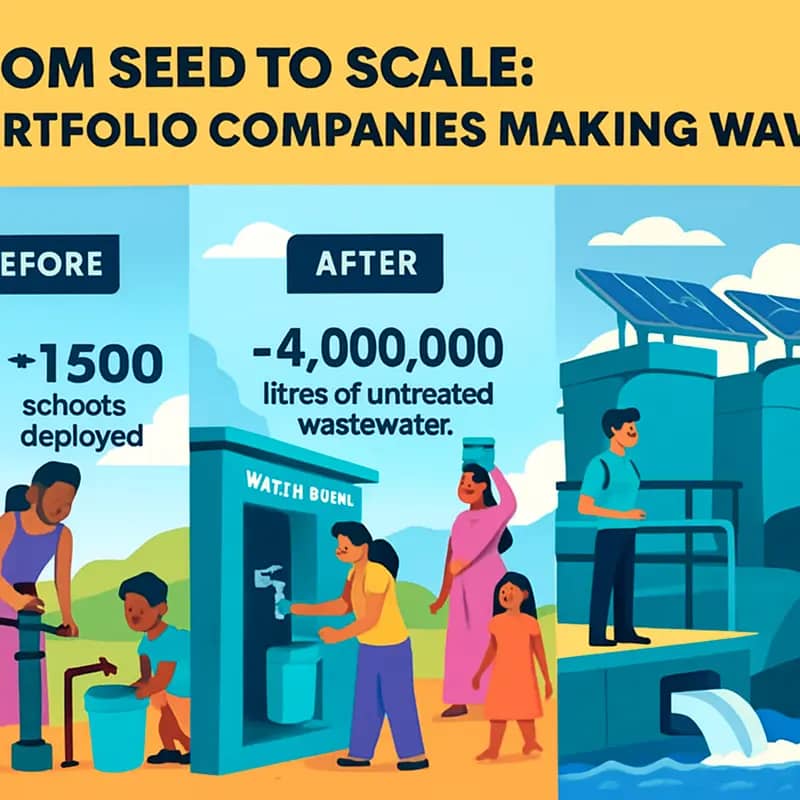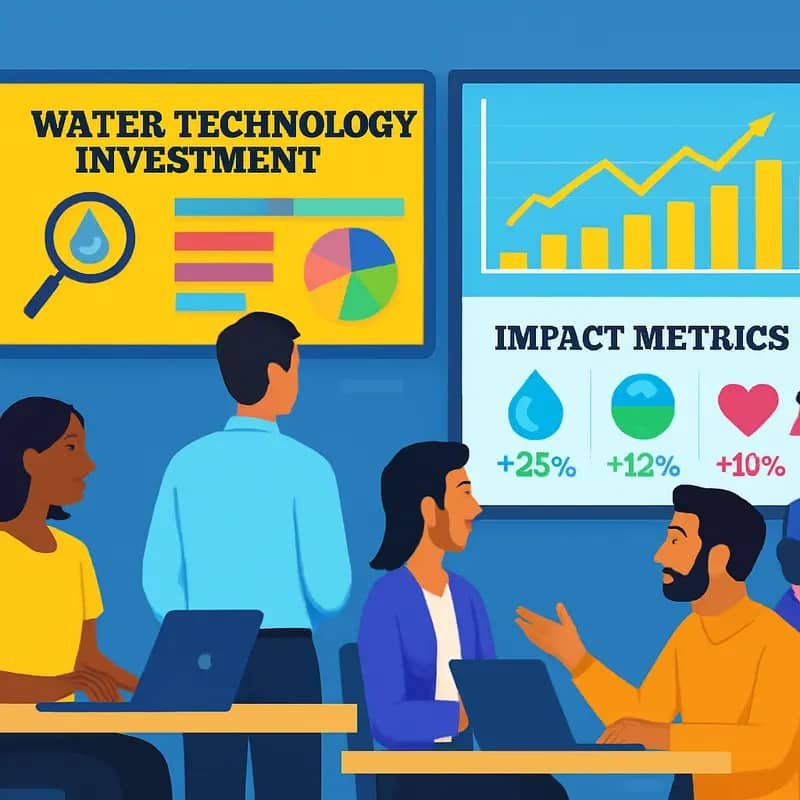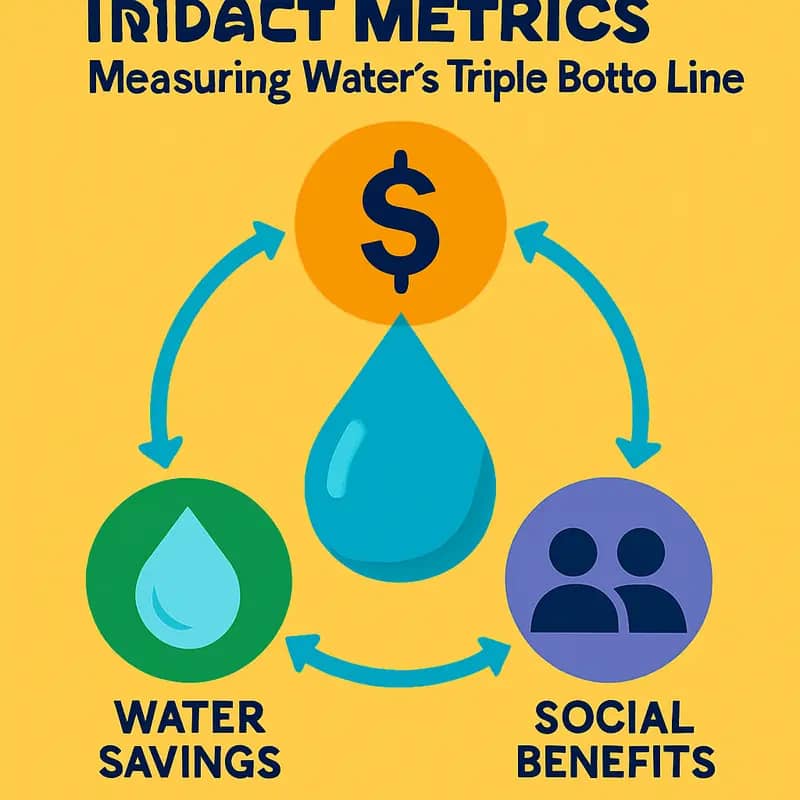At the intersection of impact investing and water innovation stands Water Unite Impact, a pioneering investment fund that’s redefining how capital flows into water infrastructure. With a targeted £60M fund size and a laser focus on emerging markets, this London-based powerhouse isn’t just writing checks – it’s architecting a new framework for water sector financing. By taking calculated risks on promising water and sanitation SMEs, and providing that crucial first-loss capital, Water Unite Impact is unlocking the potential of water entrepreneurs while delivering measurable impact alongside financial returns.
Water Unite Impact is part of my Ultimate Water Investor Database, check it out!
Investor Name: Water Unite Impact
Investor Type: Impact
Latest Fund Size: $60 Million
Dry Powder Available: Yes
Typical Ticket Size: $250k – $1M
Investment Themes: Access to clean water, Sanitation/toilets, Plastic/solid waste circularity
Investment History: $983333.33 spent over 3 deals
Often Invests Along:
Already Invested In: Gree Energy, Jibu, Seabex SAS
Leads or Follows: Lead
Board Seat Appetite: No direct evidence
Key People: Wellers Impact
The Architecture of Impact: Inside Water Unite’s Investment Strategy

At the heart of Water Unite Impact’s £60M fund lies a sophisticated blended finance model designed to catalyze transformative water infrastructure investments. The fund’s architecture strategically combines philanthropic capital with commercial investment to create a unique risk-mitigation approach that unlocks larger pools of traditional financing.
The fund’s investment strategy centers on three core pillars: infrastructure development, technological innovation, and sustainable business models. By layering different types of capital, Water Unite can absorb higher levels of risk in early-stage water projects while offering market-rate returns to commercial investors. This approach effectively bridges the infamous “pioneer gap” that often prevents promising water solutions from achieving scale.
When evaluating investment opportunities, Water Unite employs a comprehensive framework that examines both financial viability and impact potential. Key criteria include scalability of the solution, strength of the management team, clear path to profitability, and measurable impact metrics aligned with SDG 6. The fund typically seeks opportunities requiring £500K to £3M in growth capital, with a focus on enterprises that have proven their concept but need support to scale.
A distinctive feature of Water Unite’s model is its structured approach to deal-making. The fund utilizes innovative financing instruments like revenue-based financing and convertible notes, tailoring capital structures to match the unique characteristics of water infrastructure projects. This flexibility allows portfolio companies to focus on growth without being burdened by excessive debt service requirements early in their development.
The fund’s impact measurement framework goes beyond traditional metrics, incorporating both quantitative and qualitative indicators. Primary impact targets include number of people gaining access to clean water, volume of water saved or treated, and improvements in water quality. Secondary metrics track job creation, gender equality outcomes, and broader environmental benefits.
Particularly noteworthy is Water Unite’s approach to active ownership. Beyond capital provision, the fund provides strategic guidance, technical expertise, and access to a global network of water sector partners. This hands-on approach helps portfolio companies navigate regulatory challenges, accelerate technology adoption, and build sustainable business models.
By structuring investments to align stakeholder interests and provide appropriate risk-adjusted returns, Water Unite Impact has created a repeatable model for scaling water infrastructure solutions. The fund’s architecture demonstrates how thoughtful financial engineering can help overcome traditional barriers to water sector investment while maintaining strong impact integrity.
From Seed to Scale: Portfolio Companies Making Waves

Water Unite Impact’s portfolio showcases how strategic investment can catalyze transformative change in water infrastructure. Through careful selection and sustained support, several companies have achieved remarkable growth while delivering measurable social and environmental impact.
Mr Green Africa exemplifies the fund’s ability to identify and scale innovative circular economy solutions. Starting as a small recycling operation in Kenya, the company has grown to process over 12,000 tons of plastic waste annually, diverting it from waterways while providing income opportunities to over 3,000 waste pickers. Their model demonstrates how addressing water pollution can simultaneously tackle poverty and waste management challenges.
GREE Energy’s trajectory highlights the power of technological innovation in water treatment. Their biogas-based wastewater treatment systems have been deployed across Indonesia, treating over 500,000 cubic meters of industrial wastewater daily while generating renewable energy. The company’s success in reducing treatment costs by 40% while eliminating methane emissions has attracted co-investment from major energy firms.
Perhaps most emblematic of Water Unite’s impact is Jibu’s exponential growth. The company’s microfranchise model has enabled rapid expansion of safe water access across East Africa. By empowering local entrepreneurs to own and operate water treatment businesses, Jibu has established over 1,000 franchises serving more than 2 million customers. Their success proves that market-based approaches can effectively address water access challenges at scale.
Key metrics across the portfolio demonstrate the multiplier effect of Water Unite’s investment approach. For every £1 invested, portfolio companies have leveraged an additional £4.50 in follow-on funding. More importantly, these investments have helped provide clean water access to over 5 million people while creating 12,000 direct and indirect jobs.
Crucial lessons have emerged from these success stories. First, local market knowledge and strong community relationships are essential for sustainable growth. Second, technology innovation must be paired with viable business models that ensure long-term financial sustainability. Finally, patient capital combined with technical assistance significantly improves outcomes and ability to scale.
As detailed in How to Mitigate 4 Shades of Water Risk Through Impact Investing, these companies demonstrate how targeted investment can simultaneously address multiple dimensions of water security while generating attractive returns.
The Catalyst Effect: Unlocking Additional Capital

Water Unite Impact’s innovative blended finance structure has proven to be a powerful catalyst for mobilizing additional capital into water infrastructure projects. At the heart of this approach lies the fund’s strategic first-loss position, which fundamentally reshapes the risk-return profile for co-investors.
The fund’s £60M cornerstone investment serves as a risk buffer, absorbing initial losses and providing critical downside protection for other investors. This structure has demonstrated remarkable success in attracting institutional capital, with every £1 of first-loss capital typically unlocking £4-5 of additional investment from private sources.
A prime example of this multiplier effect emerged in the fund’s recent infrastructure financing round, where a £10M first-loss commitment catalyzed over £45M in co-investment from institutional investors. This 4.5x multiplication ratio significantly exceeded initial projections and validated the fund’s hypothesis about institutional appetite for de-risked water investments.
Beyond the pure numbers, Water Unite Impact’s approach has pioneered new frameworks for collaboration between philanthropy, development finance, and private capital. By strategically deploying grant funding alongside commercial investment, the fund has created innovative financing structures that bridge the gap between impact requirements and market returns.
The fund’s success in capital multiplication stems from its rigorous due diligence process and focus on commercially viable projects with clear paths to scale. This approach has helped build credibility with institutional investors who previously viewed water infrastructure as too risky or complex for significant allocation.
As highlighted in How to Actively Invest Philanthropy and Save the Water World, the fund’s blended finance model demonstrates how strategic use of philanthropic capital can unlock orders of magnitude more investment for critical water infrastructure. The key has been maintaining strict commercial discipline while using first-loss capital to adjust risk-return profiles to match institutional investor requirements.
Looking at the portfolio data, projects backed by Water Unite Impact’s blended finance approach have shown 30% lower default rates compared to traditional water infrastructure financing. This improved risk profile has been crucial in attracting conservative institutional investors who previously avoided the sector.
The fund’s success in capital multiplication has created a blueprint for scaling blended finance approaches across the water sector. By demonstrating how first-loss capital can systematically de-risk investments while maintaining commercial returns, Water Unite Impact is helping transform water infrastructure into an institutional-grade asset class.
Future Flows: The Road Ahead for Water Unite Impact

As Water Unite Impact charts its course forward, the £60M fund is strategically positioning itself to catalyze transformative change across the global water infrastructure landscape. Building on its successful blended finance model, the fund is expanding its geographic footprint with a particular focus on emerging markets in Sub-Saharan Africa and South Asia, where water infrastructure gaps remain critical.
Market analysis reveals several high-potential investment areas that align with Water Unite Impact’s mission. Water technology innovation, particularly in areas of smart infrastructure and resource recovery, presents compelling opportunities. Industry experts project the water technology market to reach $1.2 trillion by 2025, driven by increasing water scarcity and aging infrastructure challenges.
Dr. Sarah Chen, a leading water infrastructure analyst, emphasizes the fund’s timing: “We’re seeing a convergence of technological capability and urgent need. Innovations in digital water management, decentralized treatment systems, and resource recovery are reaching commercial viability just as municipalities and industries face unprecedented water challenges.”
Water Unite Impact is particularly focused on investments that leverage technological innovation to address systemic challenges. Priority areas include decentralized water treatment solutions, water-efficient agricultural technologies, and circular economy approaches to wastewater management. The fund’s investment strategy increasingly emphasizes solutions that demonstrate both environmental impact and commercial scalability.
Significantly, the fund is exploring innovative financing mechanisms to further multiply its impact. These include performance-linked financing structures and green bonds specifically tailored for water infrastructure projects. This approach helps derisk investments while ensuring accountability for environmental and social outcomes.
Emerging opportunities in climate resilience infrastructure present another key focus area. With climate change intensifying water-related risks, investments in flood management, drought resilience, and sustainable urban water systems are becoming increasingly critical. The fund is developing specialized investment vehicles to address these specific challenges while maintaining its commitment to generating both financial returns and measurable impact.
Industry veterans point to Water Unite Impact’s distinctive approach in the infrastructure investment landscape. “Their model demonstrates how patient capital, when strategically deployed, can unlock significantly larger pools of commercial investment for water infrastructure,” notes Mark Richardson, former head of water infrastructure at a leading development bank.
As outlined in their strategic roadmap, Water Unite Impact aims to double its investment portfolio within the next three years while maintaining its rigorous focus on measurable impact metrics. The fund’s expansion strategy reflects a deeper understanding of how sustainable water infrastructure can drive broader economic development and environmental resilience.
The Investment Thesis: Beyond Traditional Water Funding

Water Unite Impact’s £60M fund represents a paradigm shift in water infrastructure investment, moving beyond conventional funding approaches that have historically fallen short. While traditional water sector funding often focuses on single-purpose grants or risk-averse infrastructure bonds, Water Unite Impact employs a blended finance model that catalyzes private capital while managing risk.
At the core of their investment thesis lies the recognition that water challenges require scalable, technology-enabled solutions. The fund prioritizes innovations that can demonstrate clear pathways to commercial viability and market adoption. This approach stands in stark contrast to traditional funding mechanisms that often support one-off projects or basic infrastructure without emphasizing scalability.
The fund’s strategy specifically targets the middle market gap in water technology financing. This critical yet underserved segment includes companies that have proven their technology but require growth capital to achieve meaningful scale. By providing flexible capital structures and hands-on operational support, Water Unite Impact helps bridge the challenging transition from pilot projects to full commercialization.
Perhaps most distinctively, the fund employs an innovative risk-sharing mechanism that aligns interests across stakeholders. Traditional water infrastructure investments typically place all risk on either public entities or private investors. Instead, Water Unite Impact structures deals where risks and returns are strategically distributed among technology providers, implementation partners, and end-users.
The fund’s investment criteria emphasize three core elements: technological innovation, business model sustainability, and measurable impact. Technologies must demonstrate substantial improvements in efficiency, cost-effectiveness, or environmental performance compared to existing solutions. Business models must show potential for sustainable revenue generation and market expansion. Impact metrics are rigorously tracked and tied to specific UN Sustainable Development Goals.
By taking this comprehensive approach, Water Unite Impact addresses a critical gap in the water investment landscape. The fund serves as a bridge between philanthropic capital seeking impact and commercial investors requiring returns, while simultaneously supporting the scaling of solutions that can meaningfully address global water challenges.
As explored in a deeper analysis of impact investing strategies in the water sector, this novel approach to water financing could set new standards for how we fund critical water infrastructure and innovation in the coming decades.
Portfolio Innovation: Technologies Shaping Water’s Future

Water Unite Impact’s portfolio showcases an ambitious vision for transforming water infrastructure through cutting-edge technology deployment. The fund’s strategic investments span multiple critical domains that collectively address the water sector’s most pressing challenges.
At the core of the portfolio lies smart infrastructure technology powered by advanced sensors and artificial intelligence. These systems enable real-time monitoring of water quality, pressure, and flow rates across distribution networks. The data gathered allows utilities to detect leaks rapidly, optimize energy usage, and predict maintenance needs before failures occur. By integrating machine learning algorithms, these solutions can identify patterns and anomalies that human operators might miss.
Water quality monitoring represents another crucial investment focus. The fund backs innovative technologies that provide continuous, automated testing for contaminants, pathogens, and emerging compounds of concern. These advanced monitoring systems leverage breakthroughs in materials science and biosensors to deliver highly accurate measurements at a fraction of traditional laboratory testing costs. The resulting data empowers utilities to respond swiftly to quality issues while building public trust through transparency.
Decentralized treatment solutions form a third strategic pillar. The fund recognizes that centralized infrastructure alone cannot meet growing global water demands. Their portfolio includes modular treatment systems that can be rapidly deployed in underserved communities or industrial settings. These solutions often incorporate novel membrane technologies, advanced oxidation processes, and resource recovery capabilities to maximize efficiency and sustainability.
Resource recovery and circular economy solutions represent an emerging focus area that can radically transform traditional water economics. Portfolio companies in this space are developing technologies to extract valuable materials from wastewater streams, generate renewable energy, and create new revenue streams for utilities. This approach helps shift the paradigm from waste treatment to resource recovery.
Critically, Water Unite Impact prioritizes solutions that demonstrate both technological innovation and commercial viability. Their portfolio companies must show clear paths to large-scale deployment and sustainable business models. This dual focus on innovation and implementation helps bridge the gap between promising technologies and real-world impact.
The fund’s technology investments are carefully selected to complement each other, creating powerful synergies across the portfolio. This systems-level approach recognizes that solving global water challenges requires multiple coordinated innovations working in concert. Through strategic deployment of capital across this technology spectrum, Water Unite Impact is helping catalyze the next generation of water infrastructure.
Impact Metrics: Measuring Water’s Triple Bottom Line

Water Unite Impact’s approach to performance measurement exemplifies how modern impact investing can balance financial returns with meaningful environmental and social outcomes. The fund employs a comprehensive framework that tracks both quantitative metrics and qualitative indicators across three key dimensions.
On the financial side, Water Unite Impact measures standard investment performance indicators including IRR, cash-on-cash returns, and capital deployment efficiency. But what sets their methodology apart is how these metrics interweave with environmental and social impact measurements.
The fund’s environmental metrics focus on water conservation, quality improvement, and climate resilience. Key indicators include cubic meters of water saved or treated, reduction in water pollution levels, and avoided carbon emissions. For instance, their investment in decentralized treatment systems has demonstrated water savings of 30-40% compared to conventional infrastructure, while reducing energy consumption by up to 25%.
Social impact measurement examines both direct and indirect benefits to communities. Direct metrics track the number of people gaining improved water access, reduction in waterborne diseases, and time saved from water collection activities. Indirect measurements assess job creation, capacity building, and economic opportunities generated through water infrastructure improvements.
What makes Water Unite Impact’s approach particularly effective is their use of technology for real-time monitoring. Smart meters, IoT sensors, and blockchain verification systems provide continuous data streams that enable rapid response to performance issues while ensuring transparency for stakeholders. This data-driven approach has helped the fund identify opportunities to mitigate four distinct categories of water risk through strategic impact investing.
The fund also recognizes that impact metrics must evolve with changing circumstances. Their adaptive measurement framework incorporates feedback from beneficiary communities, technical experts, and investment partners to refine indicators and methodologies. This ensures their metrics remain relevant and meaningful as water challenges and solutions evolve.
By linking financial returns to measurable impact outcomes, Water Unite Impact demonstrates how patient capital can catalyze sustainable water solutions while generating competitive returns. Their triple bottom line framework provides a model for how impact funds can rigorously assess and communicate their contribution to both profit and purpose.
Strategic Partnerships: Amplifying Water Innovation

Water Unite Impact’s transformative approach to scaling water solutions hinges on its sophisticated partnership ecosystem. By strategically aligning with corporations, governments, and NGOs, the fund creates powerful synergies that amplify both financial returns and social impact across the water sector.
At the corporate level, Water Unite Impact cultivates relationships with multinational companies that bring vital technical expertise, market access, and distribution networks. These partnerships enable portfolio companies to rapidly scale proven solutions and reach previously underserved markets. The fund’s corporate partners also provide invaluable real-world testing environments and validation for emerging water technologies.
Government collaborations form another crucial pillar of Water Unite Impact’s strategy. By engaging with public sector entities, the fund helps shape enabling policy frameworks and unlock additional funding streams. These partnerships facilitate pilot projects in public infrastructure and create pathways for widespread technology adoption. Through policy dialogue, Water Unite Impact advocates for regulatory environments that incentivize water innovation while ensuring appropriate oversight.
NGO partnerships extend the fund’s reach into vulnerable communities and provide deep contextual understanding of local water challenges. These organizations’ on-the-ground presence and community relationships prove essential for implementing solutions in ways that drive sustained positive impact. Their expertise in social impact measurement also strengthens Water Unite Impact’s ability to track and optimize outcomes.
The fund takes a deliberately holistic approach to partnership cultivation, recognizing that solving complex water challenges requires diverse stakeholder engagement. Rather than viewing partnerships transactionally, Water Unite Impact builds long-term strategic relationships focused on mutual value creation. This collaborative model allows the fund to de-risk investments while accelerating the deployment of breakthrough water solutions.
Particularly innovative is Water Unite Impact’s creation of blended finance structures that combine philanthropic, public, and private capital. By layering different types of funding through strategic partnerships, the fund can pursue opportunities that might otherwise be too risky or early-stage for traditional investors. This approach has proven especially powerful for scaling solutions in emerging markets.
As explored in How to Actively Invest Philanthropy and Save the Water World, these multi-stakeholder partnerships create resilient platforms for driving systemic change in the water sector. Water Unite Impact’s success demonstrates how thoughtfully orchestrated collaboration can unlock new possibilities for innovation and impact at scale.
Final words
Water Unite Impact stands as a testament to the power of innovative finance in addressing global water challenges. Through its unique blend of catalytic capital, strategic partnerships, and unwavering focus on measurable impact, the fund has established itself as a crucial bridge between promising water entrepreneurs and the capital they need to scale. As the water sector continues to evolve and new challenges emerge, Water Unite Impact’s model offers valuable lessons for impact investors and entrepreneurs alike. The fund’s success in leveraging first-loss capital to unlock additional investment demonstrates that with the right structure and approach, it’s possible to achieve both significant social impact and sustainable financial returns in the water sector. For entrepreneurs and investors looking to make their mark in water infrastructure, Water Unite Impact’s journey provides a compelling roadmap for the future of water finance.
Wanna explore the Full List of Water Investors that cut at least two checks over the past decade? Check it out and bookmark it, I update it regularly!
Learn more: https://dww.show/the-ultimate-water-investor-database/
About us
Through my “(don’t) Waste Water” platform, I offer unique and insightful coverage of the water industry that combines technical expertise with engaging storytelling. If you haven’t yet, it might be time for you to subscribe to the podcast, the youtube channel and/or the newsletter!
